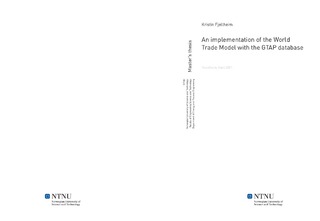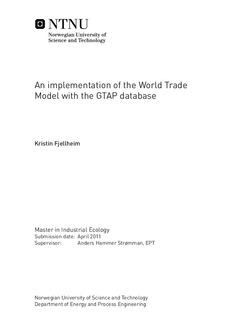| dc.contributor.advisor | Strømman, Anders Hammer | nb_NO |
| dc.contributor.author | Fjellheim, Kristin | nb_NO |
| dc.date.accessioned | 2014-12-19T11:46:31Z | |
| dc.date.available | 2014-12-19T11:46:31Z | |
| dc.date.created | 2011-07-05 | nb_NO |
| dc.date.issued | 2011 | nb_NO |
| dc.identifier | 429672 | nb_NO |
| dc.identifier | ntnudaim:6330 | nb_NO |
| dc.identifier.uri | http://hdl.handle.net/11250/234300 | |
| dc.description.abstract | In this thesis the world trade model with bilateral trade is applied to a large database. The model is based on the economic theory of comparative advantage, equilibrium production levels and benefit of trade. Statistical data on a large number of countries and sectors are applied to the model. Input-output calculations are used to convert the statistical variables to the necessary technology coefficient matrix, factor coefficient matrix and transportation matrix. These matrices are the basis for the world trade model with bilateral trade. The no trade version of the model, where there is no international trade, is solved to give grounds for comparison and the use of the benefit-of-trade constraint. The world trade model with bilateral trade opens up for trade based on comparative advantage. In addition the cost of transportation between countries is included so to integrate the cost and environmental consequences of different trade patterns. The model is applied with a large database from GTAP that provides information on 113 countries, 57 sectors, 5 primary factors, and 3 transportation sectors. The statistical values are in US dollars for the year 2004. The model solves for an alternative production layout and trade pattern based on comparative advantage, which would reduce the primary factor and product use. Comparing the statistical values to the model values gives a clear picture of the effect of comparative advantage on international trade. The total production levels were reduced due to lower inter-industry demand. The primary factor use was consequently reduced both from a lower production level and because production occurs in the country with comparative advantage. Higher levels of international trade were also observed due to production being more widespread. Even though emissions were not calculated in this thesis, the overall reduction indicates lower levels, as well as the reduced use of natural resources and land. This thesis is the first step to apply the world trade model with bilateral trade to a large database, hence some desired aspects were not included. Suggestions as to how the model can further be developed by including more constraints are put forth, such as restriction on factor movements, distances and transportation costs. The results clearly show the benefit of having a world economy based on comparative advantage. It illustrates how it is possible to have sustainable development by keeping the same consumption level as we have today while simultaneously reducing factor use. | nb_NO |
| dc.language | eng | nb_NO |
| dc.publisher | Institutt for energi- og prosessteknikk | nb_NO |
| dc.subject | ntnudaim:6330 | no_NO |
| dc.subject | MSINDECOL Industriell Økologi | no_NO |
| dc.subject | Environmental Systems Analysis | no_NO |
| dc.title | An implementation of the World Trade Model with the GTAP database | nb_NO |
| dc.type | Master thesis | nb_NO |
| dc.source.pagenumber | 82 | nb_NO |
| dc.contributor.department | Norges teknisk-naturvitenskapelige universitet, Fakultet for ingeniørvitenskap og teknologi, Institutt for energi- og prosessteknikk | nb_NO |

